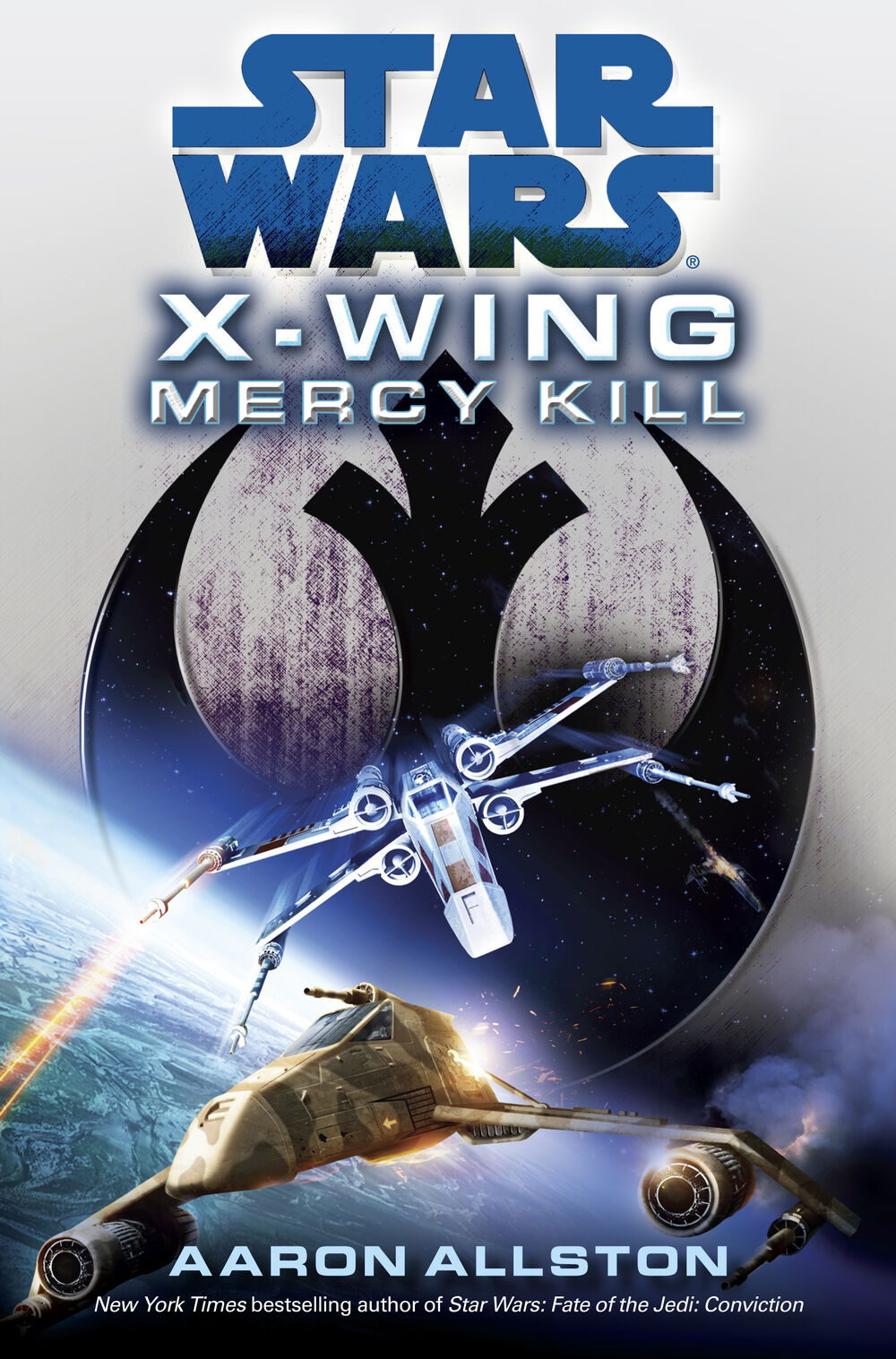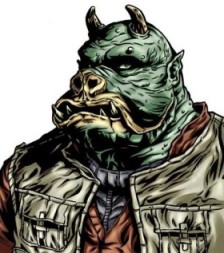Author's Note: The following review contains mentions of some characters appearing in the novel, so it may be a very minor spoiler for those who haven't yet seen the Dramatis Personae.
Leave it to Aaron Allston to get the band back together, no not the Cantina Band, but the WRAITHS. In the early days of the New Republic Rogue Squadron Commander Wedge Antilles saw the need for a new breed of special forces, individuals that possessed diverse commando skills and secondarily where capable Starfighter pilots. Of course Wedge ended up choosing a motley crew of individuals that went on to be featured in Allston's 5th, 6th and 7th novels in the X-Wing series, Wraith Squadron, Iron Fist and Solo Command.
If you have yet to read the X-Wing series, I cannot recommend enough reading that series before you read Mercy Kill. It would also be beneficial to read the Fate of the Jedi series, as the plot revolves around one of the subplots withing that series. Mercy Kill is in and of itself a fully self contained story. Through the use of flash-backs and exposition to provide important back ground and context for the characters involved. What Allston does that is important to good storytelling is strike the balance between catering to new audiences and returning audiences, you have to assume fans will have read the other books but you can have some touchstones in the story to jog their memory.
Mercy Kill is a return to a cast of characters many years since we have last seen them except in brief moments. Most people will recognize the obvious skill with which Allston wields humor, especially when writing the Wraiths. In the original Wraith novels, comedic reprobate Wes Janson was the frequent purveyor of humor.
Mercy Kill is a return to a cast of characters many years since we have last seen them except in brief moments. Most people will recognize the obvious skill with which Allston wields humor, especially when writing the Wraiths. In the original Wraith novels, comedic reprobate Wes Janson was the frequent purveyor of humor.
Less well recognized than Allston's comedic chops are his ability to convey emotion and create scenes and situations that force the reader to experience his novels in a very visceral way. In Mercy Kill, Allston takes one of the more interesting characters created in the Expanded Universe, Voort "Piggy" saBinring, a super-intelligent Gamorrean who was surgically altered not only to be vastly more intelligent than the rest of his species but was also given the ability to talk.
There is a bit of Frankenstein's monster in the make up of Piggy, both Piggy and the monster where created in a laboratory, they did not choose their state of being. Both Piggy and the monster experience extreme social isolation based on their natures. I am fascinated by the idea that while we consider intelligence a gift, there is a certain bliss in ignorance. If Piggy was never altered, he could have perhaps led a perfectly happy Gamorrean life with a rubenesque wife and three little piglet off-spring? It is Piggy's intelligence that both creates this social barrier with the rest of his species and makes him aware of his isolation.
Piggy's story may also ring true with military veterans or people who have known military veterans. The generation of characters that Piggy is from where born into and lived in constant conflict against the Empire and its remnants. Piggy found not only his purpose but also what he was good at in Wraith Squadron. How does one adjust to life outside of that military structure? How does one handle the emotions of what one had to do during war time when the surge of adrenaline high emotions of combat wane? How does one adjust to a world that has moved on, when you are still reliving an event or series of events?
I could go on and on about how much I love the choice of Piggy as the emotional backbone of this novel, but I would rather talk about it after you read it. We need more off-beat leading characters the SWEU, apologies to random human male Jedi A and random human female Jedi B.
Piggy's story may also ring true with military veterans or people who have known military veterans. The generation of characters that Piggy is from where born into and lived in constant conflict against the Empire and its remnants. Piggy found not only his purpose but also what he was good at in Wraith Squadron. How does one adjust to life outside of that military structure? How does one handle the emotions of what one had to do during war time when the surge of adrenaline high emotions of combat wane? How does one adjust to a world that has moved on, when you are still reliving an event or series of events?
I could go on and on about how much I love the choice of Piggy as the emotional backbone of this novel, but I would rather talk about it after you read it. We need more off-beat leading characters the SWEU, apologies to random human male Jedi A and random human female Jedi B.
Taking place primarily in 44 ABY it is hardly surprising that we find the Wraiths in various different places in their lives. Allston provides a nice mixture of returning characters (Wedge, Face, Piggy, Bhindi) and new characters (Trey, Truman, Scut) or semi-new characters (Jesmin and Myri) who are getting their first chance in the spotlight. Taking a step back from Mercy Kill for a minute, the ability to push pre-existing secondary characters into the forefront or to introduce new compelling characters is essential for the long term health of the Star Wars Expanded Universe. There are only so many times when the big three (Han, Luke, Leia) can save the galaxy as septuagenarians and as the next generation approaches middle age, it almost feels at times that the SWEU has missed the hand off of the lightsaber between generations. With Ben Skywalker and Alana taking center stage it is really the third generation of the SWEU characters that are coming to the forefront of story telling.
Without going to deep into the story and spoil elements, jokes or the overall readers enjoyment, I just wanted to highlight two other characters that appear in the novel that I particularly enjoyed.
Myri Antilles will make fans smile. The daughter of a fighter jock and an spy would seem like the perfect candidate to add to Wraith Squadron, the fact that she also picked up some less then savory skills and contacts amidst the gamblers dens aboard the Errant Venture is just the cherry on top of her characterization. Myri has some great lines in this book, and if this reader had his druthers she would be a key player in future Star Wars novels. More Myri please.
The other character that I really enjoyed was Scut. I don't think it is giving too much away to say that Scut is a member of the Yuuzhan Vong species. With the exception of the Legacy comic series there has been a rather noticeable absence of the Vong from post New Jedi Order novels. We will get references to them, we will see the results of the invasion, but the characters and the species themselves seem to be gone and forgotten along with Zonama Sekot. Scut's very presence provides emotional tension and lets Allston play with some very real world realities in this story.
While the Bantam era of Star Wars story telling often felt like Super-weapon of the week story telling, the Del Rey era has come to feel often like one grand galactic conflict after another. The beauty of Mercy Kill is that it's plot revolves around a rather minor sub-plot from the Fate of the Jedi series. In the grand scheme of galactic history, the plot of Wraith Squadron would be but a small blip, but in telling this minor story the characters are allowed to shine. Allston succeeds in recognizing what to many writers fail to comprehend, it is not the scale of the conflict that creates drama, it is the conflict within and amongst the characters that creates the drama.
After reading Mercy Kill, the best compliment that I can pay is that I adore this novel, and if you are a fan of the Wraiths I think you will as well.
Myri Antilles will make fans smile. The daughter of a fighter jock and an spy would seem like the perfect candidate to add to Wraith Squadron, the fact that she also picked up some less then savory skills and contacts amidst the gamblers dens aboard the Errant Venture is just the cherry on top of her characterization. Myri has some great lines in this book, and if this reader had his druthers she would be a key player in future Star Wars novels. More Myri please.
 |
| Vua Rapuung |
The other character that I really enjoyed was Scut. I don't think it is giving too much away to say that Scut is a member of the Yuuzhan Vong species. With the exception of the Legacy comic series there has been a rather noticeable absence of the Vong from post New Jedi Order novels. We will get references to them, we will see the results of the invasion, but the characters and the species themselves seem to be gone and forgotten along with Zonama Sekot. Scut's very presence provides emotional tension and lets Allston play with some very real world realities in this story.
While the Bantam era of Star Wars story telling often felt like Super-weapon of the week story telling, the Del Rey era has come to feel often like one grand galactic conflict after another. The beauty of Mercy Kill is that it's plot revolves around a rather minor sub-plot from the Fate of the Jedi series. In the grand scheme of galactic history, the plot of Wraith Squadron would be but a small blip, but in telling this minor story the characters are allowed to shine. Allston succeeds in recognizing what to many writers fail to comprehend, it is not the scale of the conflict that creates drama, it is the conflict within and amongst the characters that creates the drama.
After reading Mercy Kill, the best compliment that I can pay is that I adore this novel, and if you are a fan of the Wraiths I think you will as well.






I just finished Mercy Kill and I completely agree with you. Far too many Star Wars books are about huge events and huge threats that when you look at them all together it makes you wonder why the Yuuzhan Vong that galaxy would be a decent place to set up shop in. The real strength of the Star Wars universe is the fantastical and technological wonders that many of the inhabitants have direct access to. But all the cool in that galaxy (if I may use cool as a noun) is only going to be interesting if the reader can be made to care about the people living in it. What Alston and Stackpole were able to do is show us that we don’t need to have a person from a movie to care about them. I mean, Wedge was barely a character in the movies and I had no interest in him until I read the X-Wing series. Thanks for letting me rant.
ReplyDelete